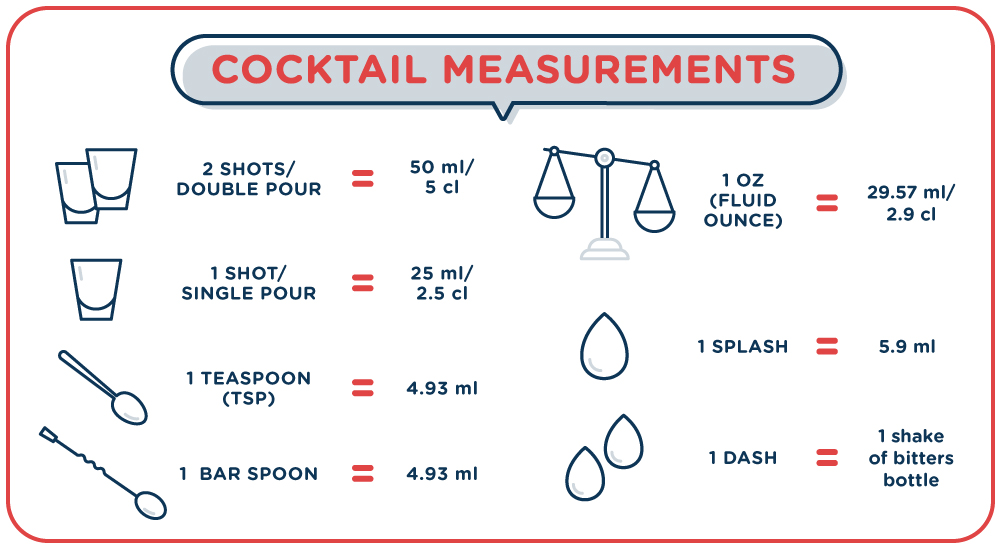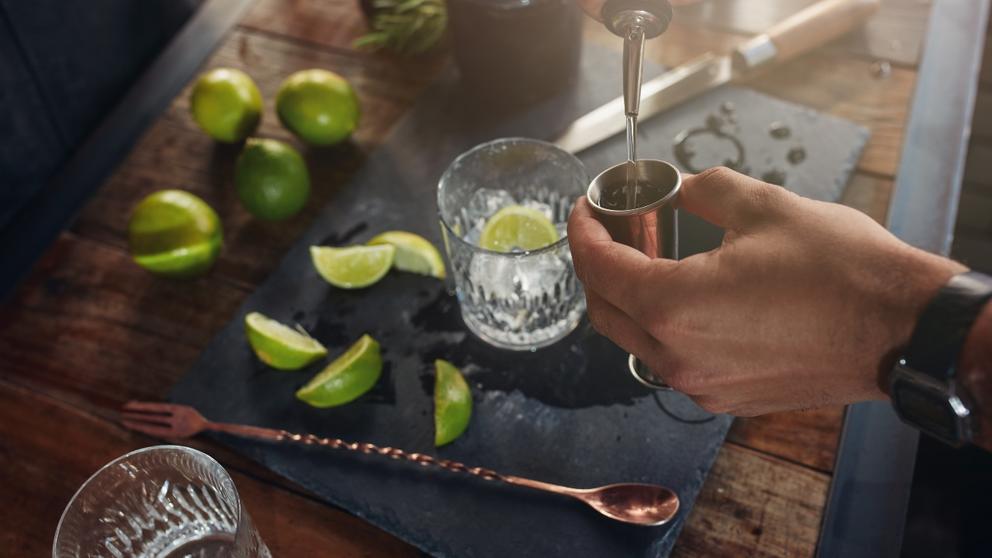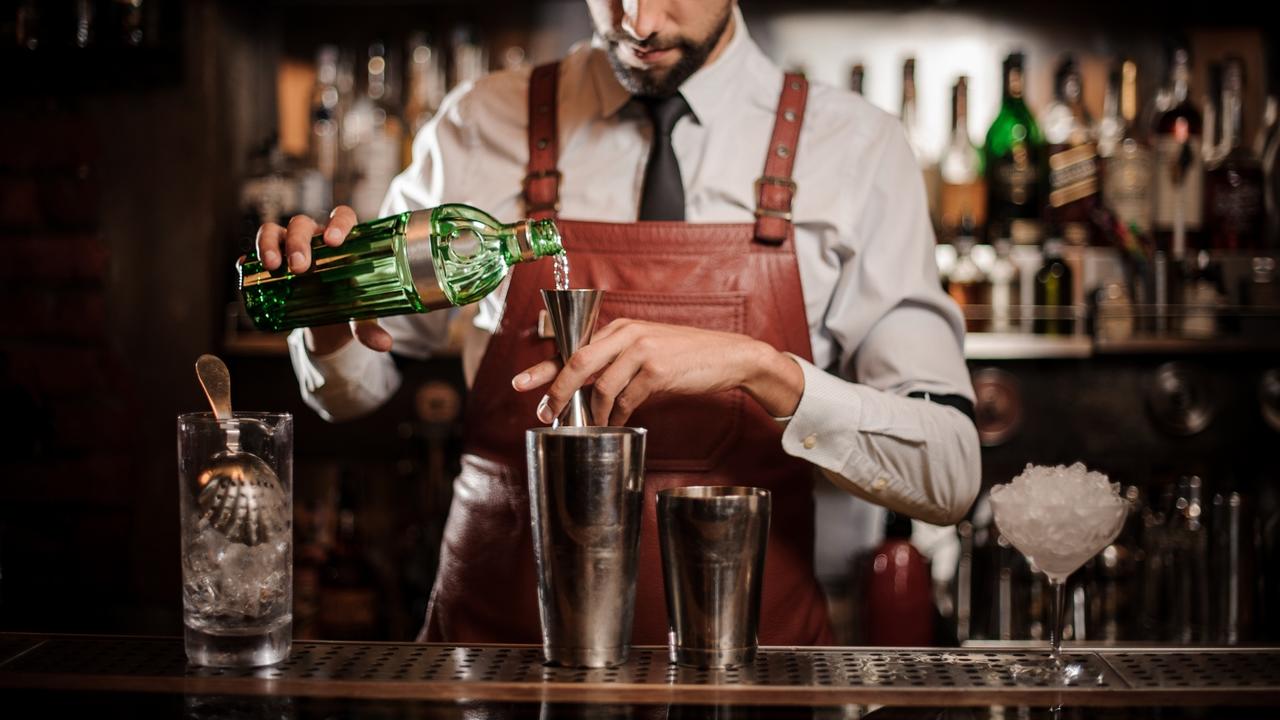The art of cocktail-making is all about balance - and measuring the right amount of each ingredient into a cocktail is vital to its success. Which is why us bartenders work from cocktail recipes (with precise measurements), ensuring that we can produce consistent drinks over and over again.
So, if you’ve ever wondered how many ml are in a single pour, or the cl in a shot of vodka, then we will answer all your questions…
There are 2 different systems of measurements used around the world - metric and imperial. Both of these systems and their slight variations are explained here, plus other terms of cocktail measures that you might find in any cocktail recipe…

Metric Cocktail Measurements
Most of us will be familiar with the metric system, as it’s the official one used in almost all countries around the world. Metric measurements are considered the 'bartender basics' in bartending.
You’ll find it in two forms behind the bar, milliliters (ml) and centiliters (cl); with ml being the most common unit of measurement. However they are interchangeable with 1cl equalling 10ml.
The IBA (International Bartenders Association), uses the metric system for all of their official cocktail recipes. They work in centiliters and therefore don’t use the term shot, rather they just note the cl equivalent. So that:
-
1 Shot/or a Single Pour = 25ml/2.5cl
-
Double Shot/ or a Double Pour = 50ml/5cl
These are your base measurements and any other terms of measure relating to shots, half shot, quarter shot, and so forth are the equivalent amount of a full shot.
The shot of 25ml/2.5cl is considered a metric ounce and you will hear people refer to it as such; read on to find out about the Imperial or “original” ounce.
Find out exactly what is a jigger and how bartenders use this tool with measuring and pouring.
Imperial Cocktail Measurements
The Imperial measuring system is more archaic, nowadays only in use in 3 countries around the world; Liberia, Myanmar and the United States of America.
However, because cocktails and cocktail culture originated in the USA, many and most cocktail recipes still use imperial measurements - so it’s important to know both.
These measurements differ in size from their metric equivalents, and knowing how they measure up next to each other can be crucial in ensuring that you craft the perfect cocktail.
-
1oz (fluid ounce) = 29.57ml or 2.9cl
From information it is easy to calculate the rest of the related measurements found in cocktail recipes such as half ounces, quarter ounces, etc; and their conversions.
It is also important to note that in the USA 1oz does not equal 1 shot.
In other parts of the world a single pour or shot is a designated measurement, however in the USA bars are free to define their own single pour and double pour.
-
The US national standard is that a single pour or shot is 1.5oz (44.3ml or 4.4cl) and a double pour is 2oz (59.14ml or 5.9cl).
Other Measurements

But you won’t find just ml, cl and oz listed as measurements in recipes, there are many others that are used in the bartending world.
You will also come across the liter, gallon and cup in cocktails recipes - especially for batched cocktails. Plus, some other terms from American cocktail recipes that are first defined in oz then converted into their ml equivalent. Like these:
-
1 Dash = One shake of a bitter bottle (there is actually no formal measurement for a dash).
-
1 Splash = 1/5oz or 5.9ml
-
1 Teaspoon (tsp) = 1/6oz or 4.93ml
-
1 Bar Spoon = 1/6oz or 4.93ml
FYI: Bar spoons across the world can differ in size, although standards are drifting toward 5ml.
Drink measurements
Cocktails come in all shapes and sizes, which means each delicious concoction comes with different drink measurements. Here are a few of the most popular bar measurements for drinks:
Aperol Spritz measurements
The infamous aperitif mixes bittersweet Aperol with sparkling Prosecco and soda water to create a cool sunset drink best enjoyed on a shady terrace. The measurements for Aperol Spritz are: 60ml prosecco, 40ml Aperol and 20 ml soda water. Add ice, pour, then garnish. Beautifully simple.
Gin and Tonic measures
Tangy, crisp and quintessentially British, the G&T is a classic long drink. Originally quaffed by colonials in India to keep the mossies at bay (thanks to the quinine in tonic), if you feel like drinking this icy cocktail in a leafy pub garden, here are the cocktail measurements. Served into a highball glass with a fresh lime wedge you’ll need 40ml gin and a bottle tonic.
After the fragrant gin is added, top up your glass with tonic.
Margarita measurements
Punchier than five minutes in the ring with Tyson Fury, the measurements for a margarita are as follows: 40 ml tequila,
20 ml Cointreau, 30ml fresh lime juice, 10ml Sugar syrup. Pour all the ingredients into a shaker, shake well, then pour - and don’t forget to coat the rim of your glass with salt for added pzazz.
Negroni measurements
This modern classic is a must-drink and the original Negroni recipe calls for gin, Campari, sweet vermouth and a twist of orange - making it a perfect blend of bitterness and sweet citrus flavours. Here are the Negroni cocktail measurements so you can knock one up at home: 20ml sweet vermouth, 20 ml Campari and 20 ml gin. Cheers!
Measurements & Laws
Different countries have different laws regarding the service of alcohol and to go through all of them would be exhaustive for all of us.
Your place of work can give you guidance on the legal requirements of alcohol service, measurements and pouring in your country. For example, some countries might require the use of official, government sanctioned jiggers, and require that either the metric or imperial system is used.
Free Pouring
Free pouring is the skill of being able to accurately pour different measurements i.e. 1oz, 1/2oz, 2oz, etc; based on a counting system, without the use of a jigger.
Such a skill takes time and practice, but once you’ve learnt it it will become second nature. There’re a couple of different counting methods which people use, however the method is the same, and time is the biggest element of it. Here at the European Bartender School we teach free pouring on our bartending course.
It is worth noting that not all countries will allow the free pouring of drinks, and there are different country specific rules set forth.
For example, in the USA anyone can free pour in their bar, however in Australia free pouring is not even an option for bars and bartenders. And in the United Kingdom bartenders must be trained and record and demonstrate their proficiency when free pouring drinks.
Converting Measures
As you can see, one fluid ounce (oz) is almost 20% bigger than the 25ml/2.5cl metric ounce. Substituting 1 floz (29.57ml) with a metric 25ml shot won’t do any harm, and can still produce an excellent drink; just ensure that you’re doing this with every ingredient in the recipe…
If you’re batching cocktails and don’t convert everything properly this could become a problem! But don’t worry, charts are easy to find on the internet and they’ll help you up-size recipes as well as convert them.
And best of all, nowadays jiggers are available for both systems of measurement. Plus, there are even some which carry marks for both ml and oz - making cocktail recipes with different measurements a breeze!
Find out more on cocktails and their history in our guide to what is a cocktail?

